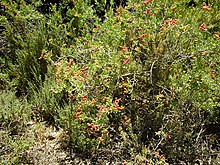
Solanum is a large and diverse genus of flowering plants, which include three food crops of high economic importance: the potato, the tomato and the eggplant. It is the largest genus in the nightshade family Solanaceae, comprising around 1,500 species. It also contains the so-called horse nettles, as well as numerous plants cultivated for their ornamental flowers and fruit.

Allocasuarina, commonly known as sheoak or she-oak, is a genus of flowering plants in the family Casuarinaceae and is endemic to Australia. Plants in the genus Allocasuarina are trees or shrubs with soft, pendulous, green branchlets, the leaves reduced to scale-like teeth. Allocasuarinas are either monoecious or dioecious, the flowers never bisexual. Male and female flowers are arranged in spikes, the female spikes developing into cone-like structures enclosing winged seeds.

Conospermum is a genus of about 50 species in the family Proteaceae that are endemic to Australia. Members of the genus are known as smokebushes - from a distance, their wispy heads of blue or grey flowers resemble puffs of smoke. They have an unusual pollination method that sometimes leads to the death of visiting insects. They are found in all Australian states, though most occur only in Western Australia. Smokebushes are rarely cultivated, though the flowers of several Western Australian species are harvested for the cut flower industry.

The term gharqad is used in some Islamic hadith segments to describe a tree which according to Sunni Islamic eschatology, will protect the Jews fighting against Muslims on the time of a great war at the end times, specifically after the second coming of Jesus according to Islam.
Mead Island is an uninhabited sand island located about 200 metres from Dirk Hartog Island in the Shark Bay World Heritage Site in Western Australia, and joined to that island at low tide. It has an area of about 800 square metres, and an elevation of two metres (7 ft).
Eagle Island is about 200 metres from Eagle Bluff on the Peron Peninsula in Shark Bay World Heritage Site in the Gascoyne region of Western Australia.

Lasiopetalum, commonly known as velvet bushes, is a genus of about forty-five species of flowering plants in the family Malvaceae, all endemic to Australia.

The crest-tailed mulgara, is a small to medium-sized Australian carnivorous marsupial and a member of the family Dasyuridae which includes quolls, dunnarts, the numbat, Tasmanian devil and extinct thylacine. The crest-tailed mulgara is among a group of native predatory mammals or mesopredators endemic to arid Australia.

Nitraria billardierei, commonly known as nitre bush or dillon bush, is a perennial shrub native to Australia. It is often found in saline areas or other areas which have been disturbed. This species produces flowers predominantly in spring, with small ovoid or oblong fruit (drupe) that are purple, red or golden. The fruit are edible, said to taste like salty grapes. They were eaten, sometimes whole, including the stone, by indigenous Australians such as the Wemba-Wemba. Fruit can also be made into jam or dried and stored. It is a broad and low shrub, up to 2 metres (7 ft) high and 4 m wide.

Enchylaena tomentosa, commonly known as barrier saltbush or ruby saltbush, is a small native shrub of Australia.
Shag Rock is a small rocky island in the Wallabi Group of the Houtman Abrolhos.

Nitrariaceae is a family of flowering plants in the order Sapindales. It comprises four genera, Malacocarpus, Nitraria, Peganum and Tetradiclis, totalling 19 species.

Nitraria retusa, commonly known as Nitre bush, is a salt-tolerant and drought-resistant shrub in the family Nitrariaceae. It can grow to heights of 2.5 metres, although it seldom exceeds more than 1 m in height. It produces small white/green coloured flowers and small edible red fruit. The plant is native to desert areas of northern Africa, where it grows in primary succession on barren sand dunes, and in areas with high salinities such as salt marshes.
Although, in modern usage, the word “nitre” usually refers to the mineral form of potassium nitrate, it may also refer to a variety of other minerals and chemical compounds, including
The Wemba Wemba language is an extinct Aboriginal Australian language once spoken along the Murray River and its tributaries in North Western Victoria and South Central New South Wales.
Cap Island Conservation Park is a protected area in the Australian state of South Australia located about 7.5 kilometres (4.7 mi) offshore, west of Mount Misery, Eyre Peninsula. The park covers Cap Island's 8ha surface. The island consists of a granite base and a calcarenite mantle; its margins steeply over-hanging and eroded. Typical vegetation is a low Nitre Bush shrubland. Cap Island Conservation Park was constituted by statute in 1972 to conserve a sea bird breeding area and Australian Sea-lion and New Zealand Fur-seal haul-out areas.
Smooth Island is an island in the Australian state of South Australia located off the west coast of Eyre Peninsula about 52 kilometres south west of the town of Ceduna. It is both part of a local group of islands known as the Isles of St Francis group and a larger group known as the Nuyts Archipelago. It has enjoyed protected area status since the 1960s and since 2011, it has been part of the Nuyts Archipelago Wilderness Protection Area.

.

The pale-rumped ctenotus or regal striped skink is a medium-sized species of skink with an arid distribution restricted to the Australian Mainland, which belongs to the largest group of reptiles in Australia, Ctentotus.

Nitraria schoberi, the nitrebush, is a species of flowering plant in the family Nitrariaceae. It has an Irano-Turanian distribution. Its fruit, edible and salty-sweet, are collected by local peoples and eaten fresh or preserved. Archeological evidence shows that people have been eating the fruit since Epipalaeolithic times.













